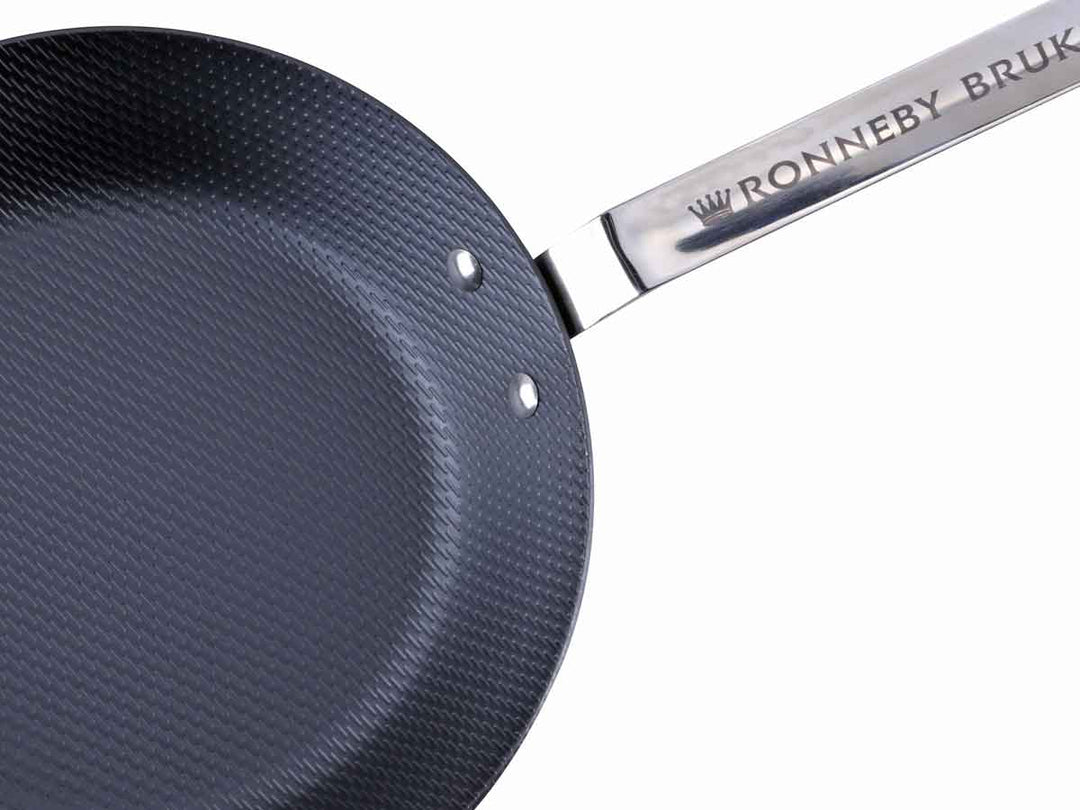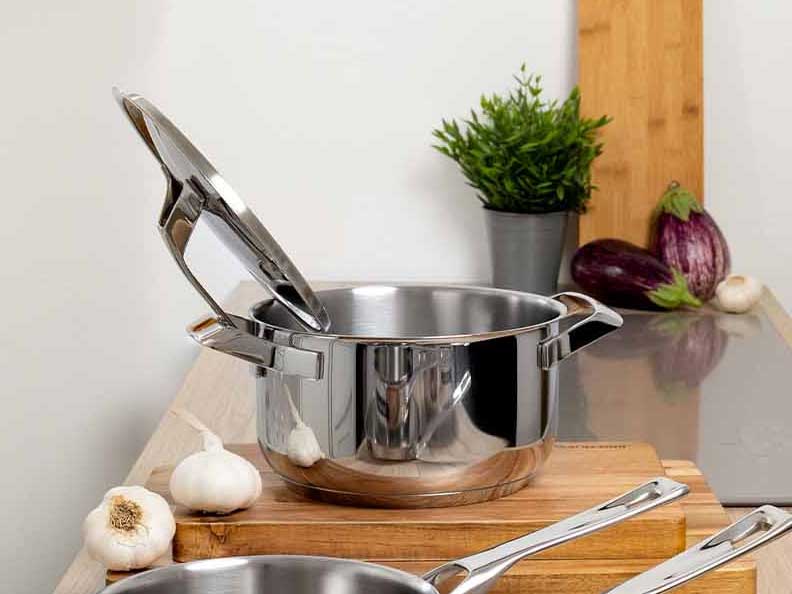Bottom not flat (hollow curvature)
Concavity - Why does the fat run to the edge?
Oil runs to the edge? Pan wobbles?
You may have noticed this with a new pan: the oil runs from the center to the edge of the pan, especially with non-stick pans. Or the cold pan wobbles a little on the glass ceramic hob (ceramic or induction). Or the floor doesn't seem to be completely flat.
Quite a few customers think they recognize a processing error or material defect. Therefore, customer questions about the phenomena described at the beginning are among the most frequently asked questions.
The property behind it is the hollow curvature, also called the bottom indentation.

Hollow arch / bottom indentation
Many customers think that a cookware base must be absolutely and 100% flat. That's not true, because physics stands in the way: Metal is known to expand when heated. Everyone has seen old train tracks that seem to meander in the blazing sun of Australia or Africa. The metal of the track expands and if there is no possibility to expand further in the longitudinal direction, the said serpentine lines are formed.
A pan that gets a totally wavy bottom when heated strongly would be extremely impractical. The bottom would buckle, resulting in permanent deformations that would render the cookware unusable.

So the base of pots, pans and roasters is given a shape that anticipates the expansion when heated in the opposite direction, so that the cookware stands firmly and securely on the stove even when frying heavily. This is done with a concave bottom shape. This shape is designed for a maximum use temperature, so that a certain concavity can remain during normal roasting.
Of course, this has the disadvantage, especially with low-fat roasts, that the oil can run off noticeably to the edge. Depending on the degree of soil penetration, this can never be completely prevented and must be accepted.
Both for the magnetic waves of an induction hob and for the thermal radiation of a radiant stove (so-called ceramic/halogen stove), the technically necessary deviations from perfect flatness in cookware and the resulting minimal empty spaces between the cooktop and cookware do not generally pose a problem in terms of preventing the functionality.
Bimetal effect: Special case of induction-suitable aluminum cookware
It should be noted that the thermal expansion of the base and, as a result, the change in the concavity varies depending on the type of cooker and size of the hob and, last but not least, the base construction of the cookware. In the case of induction-compatible aluminum and cast aluminum cookware , the concavity can tend to enlarge when heated. Why is that? Well, while aluminum is an excellent conductor of heat and therefore ideal for cookware, unfortunately it is not ferromagnetic and therefore cannot be used on induction cooktops. To remedy this and still be able to use aluminum cookware on induction, a plate made of ferromagnetic stainless steel is placed on the bottom of the aluminum cookware. This is done by hitting or pouring a perforated stainless steel disc onto or into the aluminum body or, the technically more demanding and expensive variant, by welding a full-surface stainless steel disc (Full Disc Induction), very rarely also using a plasma spray process.
However, it is the case that the two metals of the base (body made of aluminum, base plate made of stainless steel) expand to different extents when heated because they have different thermal expansion coefficients . The aluminum consequently expands more than the stainless steel. However, since the two metals are firmly connected to each other for good heat transfer, the aluminum stretches "over" the stainless steel plate, which restricts its expansion at the connection points. As a result, the concave curvature increases slightly and the oil in the pan can run to the edge more noticeably than when it is cold. This effect is purely physical and therefore under no circumstances a claimable material defect!
However, since this effect only occurs with aluminum cookware, which is always coated anyway (non-stick coating or ceramic coating), and the oil used is therefore usually poured in sparingly and not all the way, the bimetallic effect does not usually play a significant role in the frying success . Simply turn the fried food in the oil in the pan so that it is wet all over and you will have no problems frying. If you are frying something in the pan that requires a closed film of oil (frying schnitzel or similar), you will have to fill in a little more oil as an exception.
If in doubt, choose aluminum cookware with a particularly thick base (6-8mm), because this effect will be less noticeable here. Of course, such thick aluminum cookware is also significantly heavier, less handy and takes longer to heat up. But the same applies to cookware: Good things never come together....
If you don't want to put up with the inherent bimetal effect of aluminum cookware that is suitable for all stovetops / induction cookers, you can alternatively choose cookware made of stainless steel or cast iron.
And if you don't have an induction cooker and aren't planning to buy one either, you can easily choose aluminum cookware that isn't suitable for induction, i.e. doesn't have a stainless steel plate on the bottom.
"But my other pan is perfectly flat."
It is not uncommon for us to have heard such and similar sentences when explaining the topic of hollow arches / floor indentation. However, rest assured that no modern cookware is 100% flat. The reason why some cookware appears completely flat to the layperson at first glance is simply due to the fact that there are two typical courses of concavity: concentric and longitudinal courses.

In the case of the concentric, i.e. the centered course, the bottom of the cookware lies flat all around and without wobbling; the cavity (YELLOW) in the middle between the hob and the base of the cookware cannot be seen.
In the case of the longitudinal, i.e. the longitudinally directed course, there are usually two edges along a longitudinal axis of the floor. A slight wobbling of the cold cookware is noticeable here, especially on flat and expansion-neutral glass ceramic surfaces. The slight wobbling is usually reduced when heated.
Both types of concavity are common in the industry. The price and brand of the cookware are not per se an indication of one or the other type. However, the concavity of a thick base can often be concealed better through clever shaping and is therefore less noticeable.
Oval or square pans, pots and roasters
It becomes particularly difficult with cookware that is not circular, for example, that is oval, or rectangular. Since the size of the hotplate rarely corresponds exactly to the base size in such cookware, the thermal expansion in the base of the cookware is correspondingly quite uneven; there can be considerable tension in the structure of the floor. The bottom indentation usually runs lengthways and is slightly larger so that the bottom does not bowl when frying over high heat.
Nevertheless, there will always be a certain degree of unevenness, especially with large oval or square cookware, whether cast iron or aluminum, whether suitable for induction or not, whether inexpensive or expensive, not only when cold, but also at operating temperature glass-ceramic surface is of course particularly noticeable.
Please prepare your cooking accordingly and pay particular attention to slowly and gradually heating up oval / square cookware so that the heat can be better distributed in the cookware.
No reason for complaint
Please note that the presence of a proper floor indentation does not constitute a defect and is therefore not recognized by us as a reason for complaint.
Some specific product recommendations
Below are some product recommendations which, in our experience, hardly ever cause irritation to customers with regard to the curvature of the base, thanks to particularly strong bases.
You can never go wrong with this series: Chef by Beka. Pots and pans in 18/10 stainless steel with extra-strong encapsulated thermal base (6.2 mm). Wide variety of models, some also available with non-stick coating. Also perfect for induction.
Stainless steel pans that will last you a long time: Le Inoxidabili by Barazzoni. High-quality uncoated 18/10 stainless steel, a thick thermal base and a perfectly insulating plastic handle combine in the Italian-made Le Inoxidabili series to create sturdy, fun-to-use frying pans.
Solid, scratch-resistant and easy-to-clean cast aluminum induction-suitable frypans: BlackPlus by Risolì. These Italian pans have an extremely stable body with a base thickness of about 7 mm. Thanks to the Full Disc technology, the warp-free base is also perfectly suited for induction. The extraordinarily durable non-stick coating guarantees an even longer life.
Minimalist design, high quality material, very strong base: Chef Line by Barazzoni. These modern 18/10 stainless steel casseroles and pots have a base up to 1 cm thick, which guarantees long-lasting stability and optimal heat transfer.
Check first, then use!
In the case of items that have already been delivered, please check BEFORE using the cookware to see whether the bottom indentation / the concavity of the item is okay for you. Carefully remove the product packaging so that you can return the item without any deductions as part of the cancellation if you do not like it.










